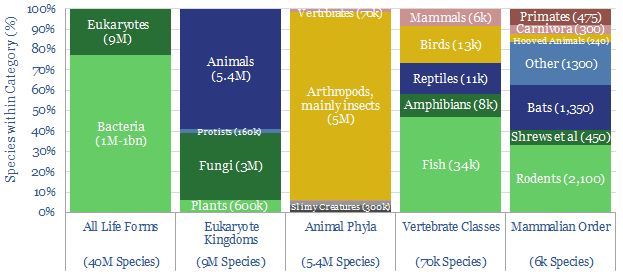A breakdown of species and carbon stocks? 550GT of Carbon is stored in the living biomass of 40M species currently inhabiting planet Earth. This is a vast number, equivalent to 0.6 tons for every ton of Carbon in the atmosphere, which totals 880GT. Hence the purpose of this data-file is to disaggregate the biomass carbon and species count of all life on Earth, for anyone looking at carbon balances and biodiversity.
Looking at the data, you could be forgiven for thinking that the carbon cycle and the composition of the atmosphere are inherently linked to the natural world, from the cyano-bacteria that first added oxygen to our atmosphere, through to sphagnum mosses that have stored another 550GT of carbon away in peat bogs. So our data-file is filled with ‘fun facts’ on different lifeforms and their inter-relationships that even increase forest productivity.
Biomass breakdown. Approximately, 350-400GT of biomass carbon is stored directly by c70,000 tree species, and 450GT is stored in 300,000 total plant species. c80GT is stored across 1M-1bn bacteria species, albeit this is an uncertain range. 12GT is in 3M fungi species. 4GT is in protists. And c3GT is stored in 5.4M animal species, of which 1.5GT of the biomass and 5M of the species-count comprises insects, also with an uncertain range.
Biodiversity is hard to define. There may be c40M species on Earth. But the chart above shows how this breaks down. In nature-based solutions to climate change, debatably, it is biodiversity across 1,500 large mammal species that is most prized; followed more broadly, by bio-diversity across c6,000 total mammals, 13,000 birds, 11,000 reptiles and 8,000 amphibian species? Land based vertebrates only total to around 40,000 species.
All inter-connected? You also cannot escape the conclusion that natural eco-systems are inter-connected. Forest-dwelling animals pollinate plants, spread seeds, consumer 500MTpa of insects and animals across the spectrum aerate forest soils. Likewise, 300 carnivore species, which make up just 0.1% of all animal biomass, influence grazing patterns that can shape entire landscapes. 90% of all plant species depend on symbiotic relationships with mycorrhizal fungi to absorb nutrients. And the natural world’s entire supply of Vitamin B12 is fixed by bacteria.
Meanwhile, in the oceans, 350,000 species of phytoplankton and blue-green algae undertake 40% of the world’s photosynthesis and oxygen generation, fixing over 100GT of atmospheric carbon per year. Many of these creatures mineralize CO2, exuding a hard exo-skeleton of calcium carbonate, which explains much of the Earth’s 1.85 billion billion tons of carbon storage in limestones, dolomites and chalks (forming entire land masses, which are also referred to as “Europe“, “Florida” and “the Middle East”).
Human impacts. Humans make up 0.06 GT of world biomass carbon. All livestock make up another 0.1GT, across a terrifying 26bn chickens and 4.5bn four-legged livestock. Livestock comprise substantively all mammal biomass. There are clear links between diet and climate. All animals comprise 0.5% of world biomass. But clearly the largest human impact, in biomass terms, is via deforestation and changing land use, which has released around 1 trn tons of CO2-equivalents, per our climate model.
A full breakdown of species diversity and biomass stocks is given in the data-file.
